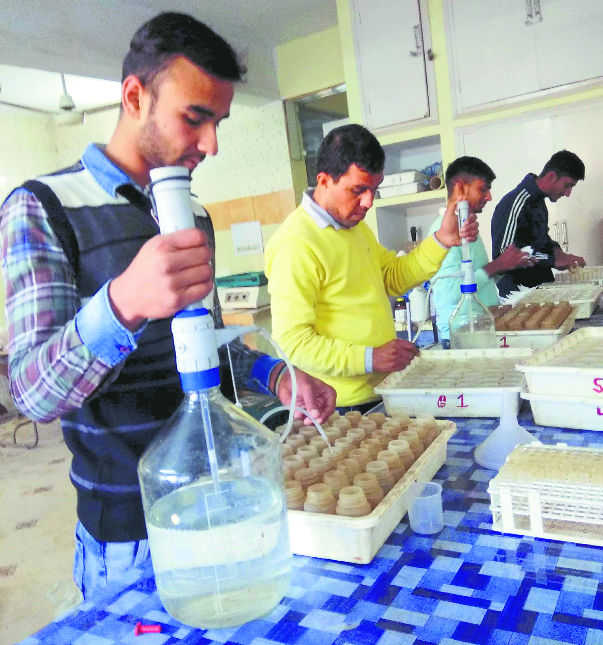
Soil samples being tested for nutritional value at a referral soil testing laboratory in Karnal.
Parveen Arora
Healthy soil is necessary for food, water and a livable climate, but soil in Haryana, which is a major contributor of food grains to the central pool, is rapidly losing its natural ability to support life. Experts say increasing pressure on limited agricultural land has resulted in overuse of chemical fertilisers, thus leading to degradation of the fertility of organic soil. The problem has emerged as a major challenge for farmers.
The soil in Haryana is deficient in nitrogen, phosphorous and potassium (known as NPK), which are major nutrients and are required in large quantities by a plant. There is no deficiency of secondary nutrients such as calcium, magnesium and sulphur, while micronutrients are lacking to some extent.
The shocking conditions came to light following the analysis of 14.14 lakh soil samples during the cycle-I (2015-17) and re-collection and re-testing of around eight lakh out of 12.45 lakh samples in the cycle-II (2017-19) under the soil health card management project, a dream project of Prime Minister Narendra Modi launched in February 2015 from Rajasthan. It aims at informing farmers about the nutrient status of soils along with recommendation of fertiliser dosage for major crops to improve soil health and fertility. Under the project, every farmer will get a soil health card of his cultivable land that will show the status of his soil along with recommendation of necessary fertilisers.
The department has set a target of analysing 12.45 lakh soil samples and distributing 42 lakh soil health cards to farmers in the cycle-II (2017-19). In the cycle-I (2015-17), the department had tested around 14 lakh samples and generated 42 lakh soil health cards. The testing of samples collected in the cycle-II is under way. So far, six lakh of eight lakh samples have been tested by the departmental network of 34 soil testing laboratories, including the State Soil Testing Laboratory in Karnal. The department has hired a private agency to analyse the remaining eight lakh samples in Karnal and Rohtak with hi-tech equipment, under the supervision of ML Khurana, retired Deputy Director, Soil Testing, Haryana. So far, the agency has analysed around 2 lakh soil samples and set a target to finish the work by March 31, 2019, so that all farmers can get their soil tested before the next crop.
The department collected samples through the geographical positioning system. One sample has been taken after every 2.5 hectares of irrigated land and one sample after every 10 hectares of non-irrigated land.
Experts say that for the production of a plant 17 types of nutrients are required. Carbon and hydrogen come to a plant from water and air, while nitrogen, potash, phosphorous, magnesium, sulphur and others come from soil.
The report on the soil health card portal says that more than 90 per cent soil in the state is deficient in nitrogen and 56 per cent has phosphorous deficiency; majorly affected districts are Sirsa, Rewari, Mahendragarh, Kurukshetra, Jhajjar and Gurugram. The deficiency of potash, which was earlier around 10 per cent in 2012-13, has increased to 25 per cent. The experts say farmers are not supplementing potash fertilisers. The soil in Yamunanagar, Rewari, Panchkula, Ambala, and Gurugram is deficient in potash.
The soil is also deficient in micronutrients. There is deficiency of zinc in 21 per cent areas, iron in 30 per cent, and manganese in 20 per cent areas, which was earlier 8 per cent in 2011-12. There is deficiency of sulphur in soil in 7 per cent areas.
The experts say soil fertility declines when the nutrients removed from soil in harvested products exceed their quantities being applied. “The extraction of nutrients from soil is high compared to nutrients added to it, resulting in this alarming situation,” says Anil Rana, Additional Director, Department of Agriculture and Farmers’ Welfare.
He adds that a judicious use of fertilisers, as recommended by experts on the soil health cards, can improve soil fertility.



























